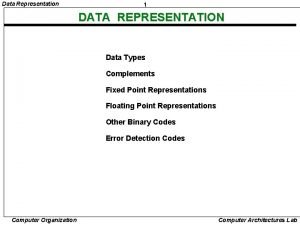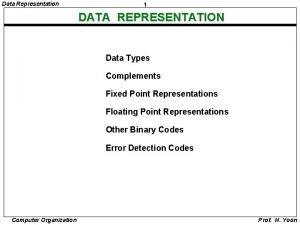Some Examples for DATA REPRESENTATION NOTE Examples are














- Slides: 14

Some Examples (for DATA REPRESENTATION) NOTE: Examples are not lectured, but it is highly recommended that you go through them to check your understanding.

Example: Disk Organization – I ü Consider a (very old) disk with the following characteristics: block size B=512 bytes gap size G=128 bytes 20 sectors per track 400 tracks per surface 15 double-sided platters disk platters rotates at a speed of 2400 RPM average seek time 30 ms (all numbers are given as a factor of 2, i. e. , KB = 2 10, MB = 220) ü What is the total capacity of a track ð Total = 20 * (512+128) = 12800 bytes = 12. 5 KB ü What is its useful capacity of a track (excluding interblock gaps) ð Useful = 20 * 512 = 10240 bytes = 10 KB INF 3100/INF 4100 – Database Systems Page 2 M. Naci Akkøk, Spring 2005

Example: Disk Organization – II ü How many cylinders are there? ð Number of cylinders = number of tracks = 400 ü What is the total capacity of a cylinder? ð Total = 15 * 20 * (512+128) = 384000 B = 375 KB ü What is the useful capacity of a cylinder? ð Useful = 15 * 20 * 512 = 307200 B = 300 KB ü What is the total capacity of the disk? ð Total = 15 * 2 * 400 * 20 * (512+128) = 153600000 B = 146. 5 MB ü What is the useful capacity of a disk? ð Useful = 15 * 2 * 400 * 20 * 512 = 117. 18 MB ü What is the average rotational delay rd? ð rd = (time for one disk revolution) / 2 = 25 / 2 = 12. 5 ms INF 3100/INF 4100 – Database Systems Page 3 M. Naci Akkøk, Spring 2005

Example: Disk Organization – III ü What is the total transfer rate (ttr)? ð ttr = (total track size in bytes) / (time for one disk revolution) = 12800 B / (60 / 2400) s = 12800 B / 25 ms = 500 KB/s ü What is the efficient (formatted) transfer rate (etr)? ð etr = (useful capacity of a track) / (time for one disk revolution) = 10240 B / (60 / 2400) s = 10240 B / 25 ms = 400 KB/s ü What is the sector transfer time (stt)? ð 512 / (512 + 128) * 360 / 20 = 14. 4 degrees per sector stt = 14. 4 / 360 * 25 ms = 1 ms INF 3100/INF 4100 – Database Systems Page 4 M. Naci Akkøk, Spring 2005

Example: Disk Organization – IV ü What is the time to transfer 4 KB (sectors in same track)? ð 7 gaps and 8 sectors must pass under disk head 14. 4 degrees per sector 128 / (512 + 128) * 360 / 20 = 3. 6 degrees per gap btt = ((8 * 14. 4) + (7 * 3. 6)) / 360 * (60 / 2400) s = 140. 4 / 360 * 25 ms = 9. 75 ms ð an approximate value may be calculated using the efficient transfer time or bulk transfer rate (btr) btr = (B/(B + G)) * ttr = 0. 8 * 500 = 400 KB/s time to transfer 4 KB 4096 / 400 KB/s = 10 ms INF 3100/INF 4100 – Database Systems Page 5 M. Naci Akkøk, Spring 2005

Example: Disk Organization – V ü How much time does it take (on average) to locate and transfer a single sector given its address? ð average time = s + rd + stt = 30 + 12. 5 + 1 = 43. 5 ms ü Calculate the average time to transfer 20 random sectors ð time = 20 * (s + rd + stt) = 20 * 43. 5 = 870 ms ü How much time is saved if the 20 sectors are stored contiguously (on same track)? ð 20 sectors and 19 gaps = 356. 6 degrees time = 30 + 12. 5 + (356. 6/360 * 25) = 67. 25 ms you save = 870 – 67. 25 = 802. 75 ms (92. 2 %) INF 3100/INF 4100 – Database Systems Page 6 M. Naci Akkøk, Spring 2005

Example: Disk Organization – VI ü Assume a process uses 100 ms to process the data in a 4 KB block. How much time is saved using double buffering compared to single buffering if we shall process 10 blocks? ð single = 10 * (retrieval time + processing time) = 10 * (9. 75 + 100) = 1097. 5 ms double = retrieval time + 10 * processing time = 9. 75 + 10 * 100 = 1009. 75 ms savings = 1097. 5 – 1009. 75 = 87. 75 ms (8 %) INF 3100/INF 4100 – Database Systems Page 7 M. Naci Akkøk, Spring 2005

Example: Disk Organization – VI ü Assume we want to read an MPEG movie in DVD quality (average 3. 5 Mbps). How many disks do we need in parallel to achieve requested bandwidth assuming (i) random placement ð 3. 5 Mbit/s 458. 8 KB/s per-disk-transfer-rate = 512 byte / (30+12. 5+1) ms 11. 5 KB/s number of needed disks = ceiling(458. 8 / 11. 5) = 40 disks ü (i) random placement, but increasing block size to 4 KB ð per-disk-transfer-rate = 4096 byte / (30+12. 5+9. 75) ms 214 KB/s number of needed disks = ceiling(458. 8 / 214) = 3 disks INF 3100/INF 4100 – Database Systems Page 8 M. Naci Akkøk, Spring 2005

Example: Disk Organization – VI ü The disk we have used is OLD. What would the total transfer time (using ð ü ð ü ð bulk/efficient transfer time) be for a 4 KB blocks if use specifications from Seagate X 15 to change (i) only data density on the platter to 617 sectors per track (20) the new track can hold 315904 B data (10240 B) etr = (useful capacity of a track) / (time for one disk revolution) = (617 * 512) B / (60 / 2400) s = 12. 05 MB/s (400 KB/s) total = 30 + 12. 5 + (4 / 12340) = 42. 5003 ms (52. 5 ms) (ii) only seek time to 3. 6 ms (30 ms) total = 3. 6 + 12. 5 + 10 = 26. 1 ms (52. 5 ms) (iii) only rotational speed to 15. 000 RPM (2400 RPM) etr = 10240 / (60 / 15000) = 10240 / 0. 004 = 2. 44 MB/s (400 KB/s) total = 30 + 2 + (4 / 2500) = 32. 502 ms (52. 5 ms) (iv) all the above etr = 315904 / 0. 004 = 75. 31 MB/s (400 KB/s) total = 3. 6 + 2 + (4 / 77125) = 5. 60005 ms (52. 5 ms) INF 3100/INF 4100 – Database Systems Page 9 M. Naci Akkøk, Spring 2005

Example: File Organization – I ü A file has r=20000 fixed-length STUDENT records. Each record has the following fields: NAME (30 bytes), SSN (9 bytes), ADDRESS (40 bytes), PHONE (9 bytes), BIRTHDATE (8 bytes), SEX (1 byte), MAJORDEPTCODE (4 bytes), MINORDEPTCODE (4 bytes), CLASSCODE (4 bytes), DEGREEPROGRAM (3 bytes) The file is stored on the disk used in the previous example. INF 3100/INF 4100 – Database Systems Page 10 M. Naci Akkøk, Spring 2005

Example: File Organization – II ü If the record header have 5 fields of 4 bytes for pointers to schema, record length, etc. Calculate the record size R in bytes ð R = record header + record fields = (4+4+4) + (30+9+40+9+8+1+4+4+4+3) = 132 B ü Calculate the blocking factor bfr ð bfr = floor(B / R) = floor(512 / 132) = 3 records per block ü Calculate the number of file blocks b needed assuming (i) an unspanned organization. ð b = ceiling(r / bfr) = ceiling(20000 / 3) = 6667 blocks (ii) a spanned organization (assume 3 * 2 B extra for record header) ð b = 138 bytes per record * 20000 records / 512 B = 5391 blocks INF 3100/INF 4100 – Database Systems Page 11 M. Naci Akkøk, Spring 2005

Example: File Organization – III ü If the 32 -bit processor requires 4 -byte alignment. What is the new record size? ð For each field: size = ceiling(old_size/4) * 4 R = 144 B ü If the block header have 3 fields of 4 bytes for ID, pointer to first record, and pointer to overflow. What is the new blocking factor? ð bfr = floor((512 – 12) / 144) = 3 records per block ü What is the new number of file blocks b needed assuming (i) an unspanned organization. ð b = ceiling(r / bfr) = ceiling(20000 / 3) = 6667 blocks (ii) a spanned organization (assume 3 * 2 B extra for record header) ð b = 156 bytes per record * 20000 records / 500 B = 6240 blocks INF 3100/INF 4100 – Database Systems Page 12 M. Naci Akkøk, Spring 2005

Example: File Organization – IV ü What is the time to retrieve the whole file assuming random placement on disk for (i) unspanned records? ð Average time to retrieve a block is 43. 5 ms Total time = 6667 * 43. 5 ms = 290 s (i) spanned records? ð Total time = 6240 * 43. 5 ms = 271 s ü How much time is saved using larger block sizes (4096 B) when using unspanned records? ð bfr = floor((4096 – 12) / 144) = 28 records per block b = ceiling(20000 / 28) = 715 blocks time to transfer one block is = 30 + 12. 5 + 9. 75 = 52. 25 ms total time = 52. 25 * 715 = 37 s savings = 290 – 37 = 253 s (87 %) INF 3100/INF 4100 – Database Systems Page 13 M. Naci Akkøk, Spring 2005

Example: File Organization – V ü Assume we want to change the order of the fields of all records, i. e. , update all fields. The update processing operation takes 1 µs (10 -6) per record. What is the time to update the database using contiguous placement and (i) single buffering, 512 B blocks, unspanned records ð 3 records per block 6667 blocks, update operation: read, update, write, verify total time = 6667 * (43. 5 + (3*10 -3) + 43. 5 + 25) = 747 s ü (ii) single buffering, 4 KB blocks, unspanned records ð 28 records 715 blocks total time = 715 * (52. 25 + (28*10 -3) + 52. 25 + 25) = 93 s ð NOTE: processing time consumes about 0. 003 % and 0. 022 % of the total time, respectively disk I/O consumes VERY much time INF 3100/INF 4100 – Database Systems Page 14 M. Naci Akkøk, Spring 2005
 Insidan region jh
Insidan region jh Difference between note making and note taking
Difference between note making and note taking Whats signal words
Whats signal words Difference between note making and note taking
Difference between note making and note taking Goods received note vs delivery note
Goods received note vs delivery note Draw a specimen of debit note
Draw a specimen of debit note What is credit note and debit note
What is credit note and debit note Note taking and note making
Note taking and note making Simple discount rate formula
Simple discount rate formula Data types in data representation
Data types in data representation Sometimes you win some sometimes you lose some
Sometimes you win some sometimes you lose some God when you choose to leave mountains unmovable
God when you choose to leave mountains unmovable The ice cream is countable or uncountable
The ice cream is countable or uncountable Contact forces
Contact forces Some say the world will end in fire some say in ice
Some say the world will end in fire some say in ice


























